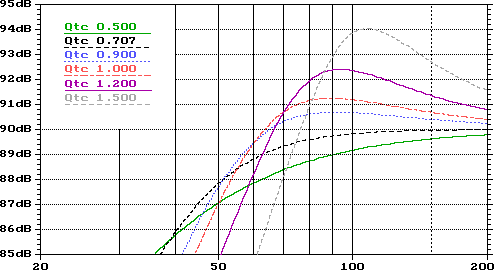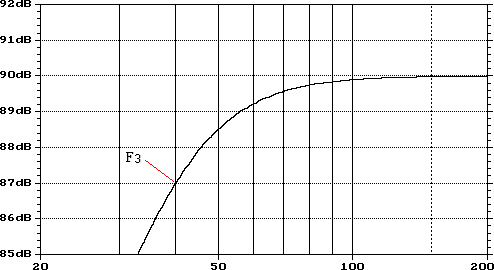Sealed Speaker Enclosure Design | ||
| Explanation of Terms | ||
| Qts, Vas, and Fs, are the electro-mechanical parameters for your woofer. They are also commonly referred to as the "Thiele-Small" parameters. You can get these from the paperwork that came with your speakers, from the dealer where you purchased your speakers, or from the manufacturer of the speaker (they are sometimes hard to contact, however). | ||
Qtc - is the total resonance of the speaker system. An enclosure with a Qtc value of 0.707 will give you the flattest frequency response and the lowest possible F3 for a given driver, use this value if you want the your music to sound as close to the original recording as possible.  Most people like the sound of boxes designed with Qtc values ranging from 0.9-1.1 which produces a slightly emphasized bass range. Values above 1.2 are undesirable because they tend to sound unnatural (the peak around the 100 Hertz range in the plot above is what most people refer to as "boomy" sound), and they also can be physically hard on the speaker. Important Qtc relationships : F3 increases for values above or below 0.707. Mechanical power handling is not the same as the manufacturers' "power rating" (which only tells how much power the voice-coil can handle without burning up, and has nothing to do with how much input power the speaker can take before it bottoms out). The speaker's suspension and the enclosure design determine the mechanical power handling of the system. | ||
| Fc - the resonant frequency of the driver when mounted to an enclosure. | ||
| Vb - the required internal volume of the enclosure. | ||
F3 - the frequency that the response is down (from the reference level) by 3 dB at. In the frequency response plot below, the reference level is 90 dB (left scale). So, the frequency (bottom scale) of F3 is at the intersection of 87 dB and 40 Hertz. Therefore, this enclosure design has an F3 of 40 Hertz. | ||
| Second-Order Speaker Enclosure Design Formulas | ||
 Typical Sealed Enclosure Design | ||
| The following formulas will allow you to design a sealed speaker enclosure for any Qtc value you desire. | ||
| Vb = Vas / | ||
| Fc = (Qtc x Fs) / Qts | ||
 | ||
If you don't want to/can't calculate an enclosure using the formulas shown above, click here to use my Javascript™ calculator, which does all of the math for you. | ||
Accessories Home Links Loudspeakers 101 Software E-Mail